 
|
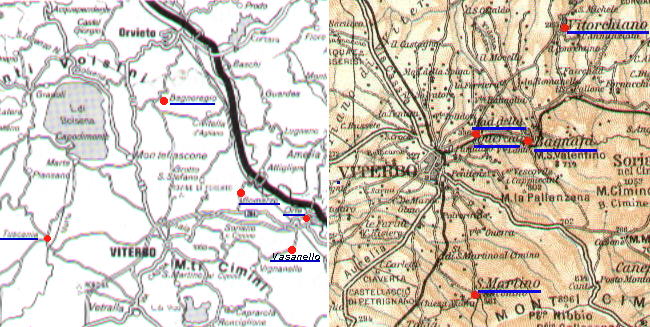 | ||
Viterbo has retained more
papal coats of arms than any other town of the former Papal State.
In the second half of the XIIIth century Viterbo became the preferred (3,319 days)
residence of the popes: in this period the iconography of the popes developed the symbols which later on became typical of papal heraldry. The popes lived in Viterbo partly because of
security needs and partly because in summer Rome and especially the Vatican were unhealthy.
The Palace of the Popes was built during this period (several conclaves were held in Viterbo and four popes are buried in its churches) and in
1276 a Loggia delle Benedizioni (blessings) was built next to the palace. The frieze above the arches showed for the first time the two keys of St Peter crossing each other.
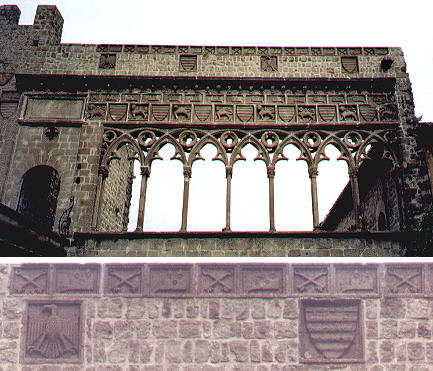 | ||
The loggia was covered and had a similar set of columns overlooking the depression of Faul, a part of Viterbo inside the walls, but almost void of buildings. In the XIVth century the roof collapsed and the loggia became an open space where Sixtus IV (1471-84) assembled a fine fountain made with elements of a XIIIth century fountain.
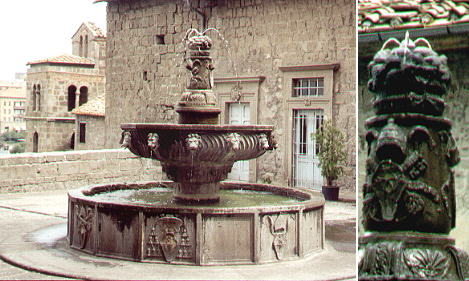 | ||
Sixtus IV was very keen on establishing the role of the pope as actual ruler of the country: so his coat of arms is at the center of the new Renaissance fašade of Palazzo Comunale, the symbol of the municipal authority. The courtyard of the palace is embellished by several papal coats of arms: the image here below shows also the baroque coat of arms of Innocentius XII (1691-1700), who had been governor of Viterbo and the Renaissance coat of arms of Paulus II (1464-71).
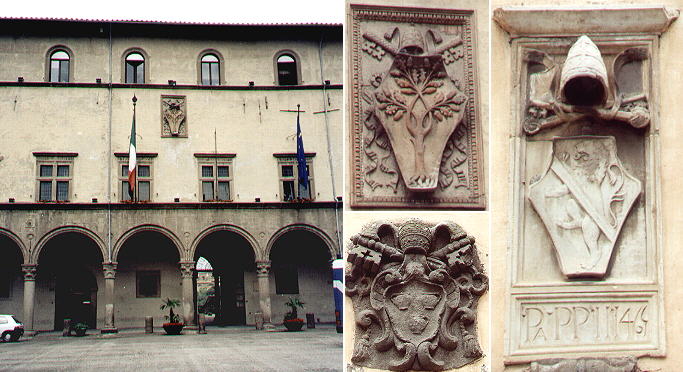 | ||
Paulus III (1534-49) (Alessandro Farnese) was born near Viterbo and he tried to leave to his family a little state having as its capital Viterbo: many towns around Viterbo (Caprarola, Ronciglione, Nepi and the Duchy of Castro) became fiefs of the Farnese. There are several coats of arms of Paulus III in Viterbo. The picture here below shows his coat of arms in the fortress of Viterbo, which had been built by Cardinal Albornoz in the XIVth century, but which was strengthened by Paulus III. The large fountain in front of the fortress was also built by the Farnese (note their lily on its top).
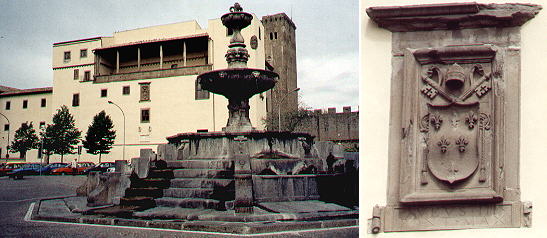 | ||
Viterbo, unlike Rome, has retained coats of arms celebrating the opening of a street or other events not related to a monument. The two coats of arms here below belong to (left) Sixtus V (1585-90) and his predecessor (right) Gregorius XIII (1572-85). In both cases they are accompanied by the coat of arms of a Farnese cardinal, as this family retained for many years a great influence over Viterbo. They also show the symbol of Viterbo: a lion holding a flag and behind the lion a palm (you see it also in the background of this page).
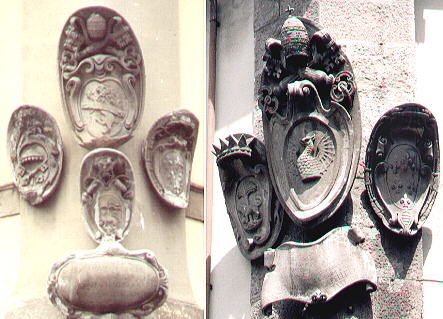 | ||
Viterbo is still protected by its medieval walls: some of the gates were modified in the XVIIth and XVIIIth century. The main gate Porta Romana was rebuilt by Innocentius X (1644-55) who had assigned to his sister-in-law Olimpia Maidalchini the nearby fief of S. Martino al Cimino. The gate was again modified by Clemens XI (1700-21) and it shows the coats of arms of both popes (left: Clemens XI; right: Innocentius X). The statue between the coats of arms shows S. Rosa, patroness of Viterbo, who in the XIIIth century led the resistance against the Emperor Frederic II. You can see a picture of Porta Romana in my page on the Walls of the Popes.
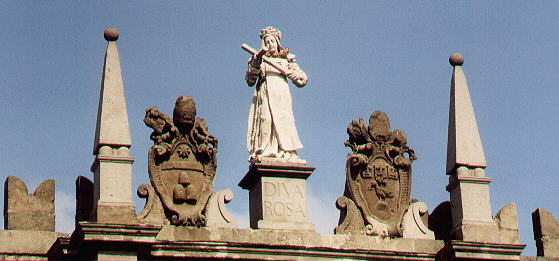 | ||
Benedictus XIII (1724-30) had a very complex coat of arms with a reference to his family (Orsini) and to his order (Dominicans). In Rome one can see his coat of arms only over his funeral monument in S. Maria sopra Minerva. Viterbo on the contrary has two coats of arms of this pope, although the excess of symbols makes them rather confused.
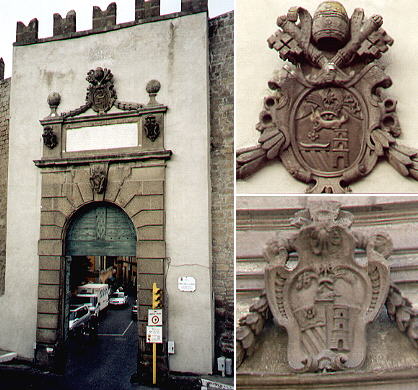 | ||
In and about Viterbo - other pages:
Bagnaia
Bagnoregio
Bomarzo
S. Maria della Querce
S. Martino al Cimino
Orte and Vasanello
Tuscania
Vitorchiano
Walks with Ferdinand Gregorovius in the Roman countryside
some other walks:
Around Monte Cimino:
Ronciglione
Caprarola, Carbognano and Fabrica
Corchiano, Vignanello and Vallerano
Soriano al Cimino
A Pilgrims' Way
Acquapendente
Bolsena
Montefiascone
On the Edge of the Marsh:
Sermoneta
Sezze
Priverno
Via Appia:
A walk to Porta Furba
Via Appia Antica from Cecilia Metella to Torre in Selci
Via Appia Antica from Torre in Selci to Frattocchie
From Civitavecchia to Civita Castellana:
Civitavecchia, Allumiere and Tolfa
Oriolo Romano and Capranica
Sutri and Monterosi
Nepi and Castel Sant'Elia
Civita Castellana
From Bracciano to Viterbo:
Manziana, Canale Monterano and Vejano
Barbarano Romano, Blera and Vetralla
In Maremma:
Corneto (Tarquinia)
Montalto di Castro and Canino
Via Prenestina:
A walk to Ponte di Nona
Via Tiburtina:
Anticoli Corrado where the painters found their models
Via Cassia:
Branching off Via Cassia: S. Maria di Galeria, Isola Farnese and Formello
Via Flaminia:
A Walk to Malborghetto
See my Home Page on Baroque Rome or my Home Page on Rome in the footsteps of an XVIIIth century traveller
All images © 1999 - 2003 by Roberto Piperno. Write to romapip@quipo.it
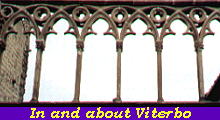 Viterbo
Viterbo